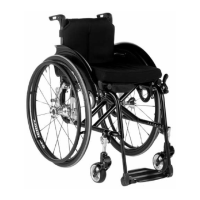Position of rear wheel Effect
Wheel camber 2°/3°/4°
• Wheelchair becomes more manoeuvrable, turns faster and tips less easily
to the side
• Seat angle to the rear increases
• Increased rolling resistance
0° position
• Narrow track, excellent straight ahead running
• Low rolling resistance
6.3.4.1 Adjustment of the 0°/2°/3°/4° rear wheel camber
The Avantgarde modular system provides a rear wheel adapter which can be used to set the rear wheels at differ
ent camber angles (0°, 2°, 3° and 4°, for CLT welded in position: 0° and 2.5°).
1) Remove the outer mounting nut of the fitting.
2) Pull the fitting out of the rear wheel adapter.
3) Remove the front/rear camber washers (see Fig.14) and replace with new camber washers (see Fig.15). The
respective wheel camber angle is engraved in the camber washer.
4) Pay attention to the following when tightening the fitting (see Fig.11):
→ Position the teeth of the camber washers offset from one another.
→ Position the groove of the camber washers as parallel and upright as possible.
5) To correct the toe angle, insert the spirit level holder into the groove (see Fig.17, item 1).
6) Insert the spirit level and align the camber washers upright (see Fig.17, item 2).
7) Tighten the nuts on both sides of the fitting to 50 Nm.
→ After adjustment, the camber of the left and right rear wheels must have the same angle.
14 15
16 17
6.4 Adjusting the Caster Wheels
6.4.1 Adjustment of the front wheel journal angle
When the rear wheels have been adjusted for the user, the castor journal angle must be adjusted at the castor
wheel adapter.
The threaded axle in the caster wheel adapter should be perpendicular to the ground to ensure optimum rolling
behaviour of the wheelchair. The caster wheel adapter permits a continuous adjustment of this angle.
14 | Ottobock
Adjustments
Avantgarde CV/CS/CLT

